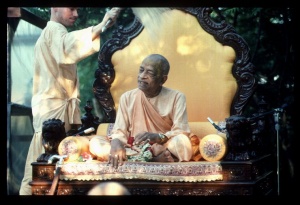SB 1.6.30: Difference between revisions
m (1 revision(s)) |
No edit summary |
||
| Line 1: | Line 1: | ||
{{info | {{info | ||
|speaker= | |speaker=Nārada Muni | ||
|listener= | |listener=Śrīla Vyāsadeva | ||
}} | }} | ||
[[Category:Srimad-Bhagavatam - Canto 01 Chapter 06]] | |||
[[Category:Bhagavatam Verses Spoken by Narada Muni - Vanisource|010630]] | |||
<div style="float:left">'''[[Srimad-Bhagavatam]] - [[SB 1|First Canto]] - [[SB 1.6: Conversation Between Narada and Vyasadeva|Chapter 6: Conversation Between Nārada and Vyāsadeva]]'''</div> | |||
<div style="float:right">[[File:Go-previous.png|link=SB 1.6.29]] '''[[SB 1.6.29]] - [[SB 1.6.31]]''' [[File:Go-next.png|link=SB 1.6.31]]</div> | |||
{{CompareVersions|SB|1.6.30|SB 1962|SB 1972-77}} | |||
{{RandomImage}} | |||
==== TEXT 30 ==== | ==== TEXT 30 ==== | ||
<div | <div class="verse"> | ||
sahasra-yuga-paryante | :sahasra-yuga-paryante | ||
utthāyedaṁ sisṛkṣataḥ | :utthāyedaṁ sisṛkṣataḥ | ||
marīci-miśrā ṛṣayaḥ | :marīci-miśrā ṛṣayaḥ | ||
prāṇebhyo 'haṁ ca jajñire | :prāṇebhyo 'haṁ ca jajñire | ||
</div> | </div> | ||
| Line 17: | Line 23: | ||
==== SYNONYMS ==== | ==== SYNONYMS ==== | ||
<div | <div class="synonyms"> | ||
''sahasra''—one thousand; ''yuga''—4,300,000 years; ''paryante''—at the end of the duration; ''utthāya''—having expired; ''idam''—this; ''sisṛkṣataḥ''—desired to create again; ''marīci-miśrāḥ''—ṛṣis like Marīci; ''ṛṣayaḥ''—all the ṛṣis; ''prāṇebhyaḥ''—out of His senses; ''aham''—I; ''ca''—also; ''jajñire''—appeared. | |||
</div> | </div> | ||
| Line 24: | Line 30: | ||
==== TRANSLATION ==== | ==== TRANSLATION ==== | ||
<div | <div class="translation"> | ||
After 4,300,000,000 solar years, when Brahmā awoke to create again by the will of the Lord, all the ṛṣis like Marīci, Aṅgirā, Atri and so on were created from the transcendental body of the Lord, and I also appeared along with them. | After 4,300,000,000 solar years, when Brahmā awoke to create again by the will of the Lord, all the ṛṣis like Marīci, Aṅgirā, Atri and so on were created from the transcendental body of the Lord, and I also appeared along with them. | ||
</div> | </div> | ||
| Line 31: | Line 37: | ||
==== PURPORT ==== | ==== PURPORT ==== | ||
<div | <div class="purport"> | ||
The duration of a day in the life of Brahmā is 4,320,000,000 solar years. This is stated also in the Bhagavad-gītā. So for this period Brahmājī rests in yoga-nidrā within the body of the Garbhodakaśāyī Viṣṇu, the generator of Brahmā. Thus after the sleeping period of Brahmā, when there is again creation by the will of the Lord through the agency of Brahmā, all the great ṛṣis again appear from different parts of the transcendental body, and Nārada also appears. This means that Nārada appears in the same transcendental body, just as a man awakes from sleep in the same body. Śrī Nārada is eternally free to move in all parts of the transcendental and material creations of the Almighty. He appears and disappears in his own transcendental body, which is without distinction of body and soul, unlike conditioned beings. | The duration of a day in the life of Brahmā is 4,320,000,000 solar years. This is stated also in the [[Bhagavad-gita As It Is (1972)|''Bhagavad-gītā'']. So for this period Brahmājī rests in ''yoga-nidrā'' within the body of the Garbhodakaśāyī Viṣṇu, the generator of Brahmā. Thus after the sleeping period of Brahmā, when there is again creation by the will of the Lord through the agency of Brahmā, all the great ''ṛṣis'' again appear from different parts of the transcendental body, and Nārada also appears. This means that Nārada appears in the same transcendental body, just as a man awakes from sleep in the same body. Śrī Nārada is eternally free to move in all parts of the transcendental and material creations of the Almighty. He appears and disappears in his own transcendental body, which is without distinction of body and soul, unlike conditioned beings. | ||
</div> | </div> | ||
__NOTOC__ | |||
<div style="float:right; clear:both;">[[File:Go-previous.png|link=SB 1.6.29]] '''[[SB 1.6.29]] - [[SB 1.6.31]]''' [[File:Go-next.png|link=SB 1.6.31]]</div> | |||
__NOTOC__ | |||
__NOEDITSECTION__ | |||
Revision as of 08:37, 30 April 2021

A.C. Bhaktivedanta Swami Prabhupada
TEXT 30
- sahasra-yuga-paryante
- utthāyedaṁ sisṛkṣataḥ
- marīci-miśrā ṛṣayaḥ
- prāṇebhyo 'haṁ ca jajñire
SYNONYMS
sahasra—one thousand; yuga—4,300,000 years; paryante—at the end of the duration; utthāya—having expired; idam—this; sisṛkṣataḥ—desired to create again; marīci-miśrāḥ—ṛṣis like Marīci; ṛṣayaḥ—all the ṛṣis; prāṇebhyaḥ—out of His senses; aham—I; ca—also; jajñire—appeared.
TRANSLATION
After 4,300,000,000 solar years, when Brahmā awoke to create again by the will of the Lord, all the ṛṣis like Marīci, Aṅgirā, Atri and so on were created from the transcendental body of the Lord, and I also appeared along with them.
PURPORT
The duration of a day in the life of Brahmā is 4,320,000,000 solar years. This is stated also in the [[Bhagavad-gita As It Is (1972)|Bhagavad-gītā]. So for this period Brahmājī rests in yoga-nidrā within the body of the Garbhodakaśāyī Viṣṇu, the generator of Brahmā. Thus after the sleeping period of Brahmā, when there is again creation by the will of the Lord through the agency of Brahmā, all the great ṛṣis again appear from different parts of the transcendental body, and Nārada also appears. This means that Nārada appears in the same transcendental body, just as a man awakes from sleep in the same body. Śrī Nārada is eternally free to move in all parts of the transcendental and material creations of the Almighty. He appears and disappears in his own transcendental body, which is without distinction of body and soul, unlike conditioned beings.